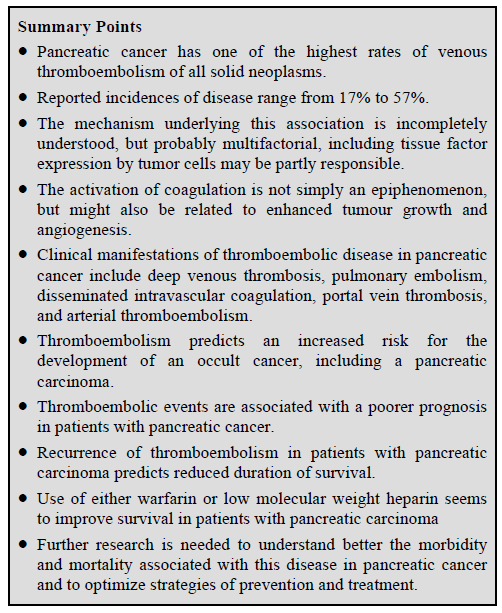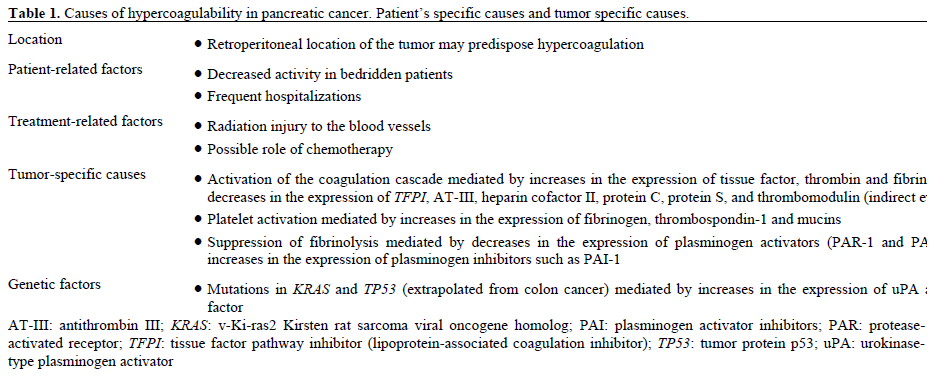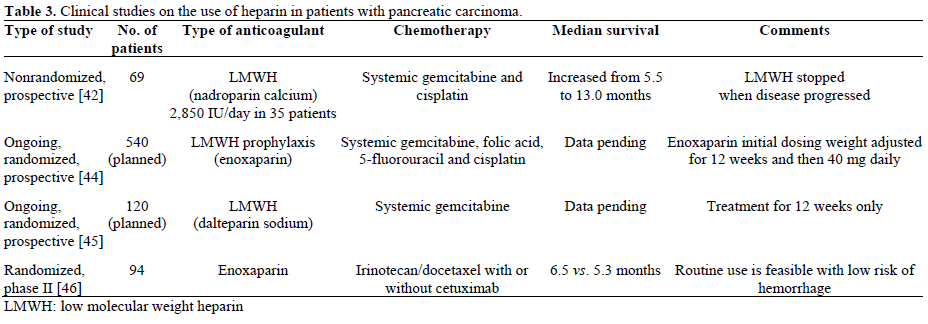- (2009) Volume 10, Issue 2
Muhammad Adnan Sohail, Muhammad Wasif Saif
Yale Cancer Center, Yale University School of Medicine. New Haven, CT, USA
Pancreatic cancer remains a major clinical challenge. Recent advances in chemotherapeutic and targeted agents have offered a modest survival benefit. One of the major complications of pancreatic cancer is venous thromboembolism. Although it is wellknown fact that patients with mucinous carcinoma of the pancreas and gastrointestinal tract pose an increased risk of developing thromboembolic complications, scarce data exists regarding the incidence and pathogenesis of venous thromboembolism in pancreatic cancer patients. The incidence of venous thromboembolism in pancreatic cancer patients ranges from 17% to 57%. Clinical data also suggest that the occurrence of venous thromboembolism may be associated with poorer prognosis in such patients. Recent data suggest that anticoagulant treatments may improve cancer patient survival by decreasing thromboembolic complications as well as by anticancer effects. Thromboembolic disease in pancreatic cancer presents a life-threatening complication and is regarded as paraneoplastic manifestation of the disease. Effective management of this risk factor is very important in the management of pancreatic cancer. Given the lack of extensive data and the clinical relevance of this topic for both physicians and basic research scientists, the authors review the incidence, pathogenesis and clinical implications of venous thromboembolism in pancreatic cancer patients.
Carcinoma; Heparin; Neoplasms; Pancreas; Pancreatic Neoplasms; Thromboembolism; Thrombophilia; Thrombosis; Venous Insufficiency; Warfarin
KRAS: v-Ki-ras2 Kirsten rat sarcoma viral oncogene homolog; VTE: venous thromboembolism; TP53: tumor protein p53
Cancer and its treatments are well-recognized risk factors for venous thromboembolism (VTE). Although the incidence of VTE in cancer patients is not well documented, there is evidence that the absolute risk depends on the tumor type, the stage or extent of the cancer, and treatment with antineoplastic agents. The most common cancer types seen in patients with thrombosis are breast, colorectal and lung, reflecting the prevalence of these malignancies in the general population. When the underlying prevalence is taken into account, cancers of the pancreas, ovary and brain are the most strongly associated with thrombotic complications. Although idiopathic thrombosis can be the first manifestation of an occult malignancy, extensive screening for cancer in these patients has not been shown to improve survival and is not warranted. Despite treatment, cancer patients with thrombosis have a poor prognosis. This is likely due to premature deaths from recurrent VTE and to the aggressive nature of the underlying cancer. Further research is needed to address the many clinical questions in the management of thrombosis in patients with cancer.

History of Association between Pancreatic Cancer and VTE
French internist Trousseau suggested the relationship between thrombosis and gastrointestinal cancer [1]. It is believed that he himself developed thrombosis and died of a gastrointestinal cancer [2, 3] and Trousseau's syndrome has been studied extensively to determine whether thrombophlebitis really predicts the presence of a visceral tumor.
Sproul was the first who demonstrated the association between thromboembolism and pancreatic cancer in 1938 [4]. Since then it has become dogma that thromboembolism is associated with pancreatic carcinoma, despite the existence of several studies that have indicated that the relationship is neither unique to pa ncreatic carcinoma nor especially common in patients with this disease [5].
Virchow made important contribution in nineteenth century when he described the consequences of embolism in the pulmonary vasculature [6, 7]. Virchow's triad consists of stasis, vascular injury and hypercoagulability which later used to explain how venous thrombosis develops. These same factors seem to be involved in cancer tissue and cause the formation of local thrombi. As the tumor-specific causes of hypercoagulability have been reviewed already [4], we discuss here the main factors, and how to manage it.
How Common is Hypercoagulability in Pancreatic Cancer
Hypercoagulability in cancer is very common. Ovarian cancer is the most common cause of thrombotic event [8]. Hypercoagulability is more common in patient of pancreatic cancer than any other type of gastrointestinal tumors. It has been reported that incidences of disease range from 17% to 57% [9]. The chances of recurrence are high in pancreatic cancer than any other type. One study found that 13.6% of patients with pancreatic carcinoma experienced a thromboembolic event during therapy [10]. However, tumors such as bladder, esophagus and breast cancers are less likely than pancreatic carcinoma to be associated with thromboembolic events [11].
Why is Hypercoagulation Common in Pancreatic Cancer?
Location
It is common because the tumor is retroperitoneal in location, decrease activity in bedridden patients, patient’s frequent hospitalization and radiation injury to the vessels.
Increased Pro-Thrombotic Factors
In pancreatic cancer, tissue factor [12, 13], thrombin [14, 15] and fibrinogen [16] level are increased. Higher concentration of tissue factor in tumor tissue has been shown to be associated with the development of thromboembolic events [13]. Plasma levels of thrombin have also been found to be elevated in patients with pancreatic carcinoma [12]
Decreased Inhibitors of Anticoagulation
The inhibitors of anticoagulation is decreased with pancreatic carcinoma add another ingredient in the hypercoagulation. These factors include antithrombin III, heparin cofactor II, protein C, free protein S, and thrombomodulin [17, 18, 19].
Increased Platelet Aggregation
Increased platelet aggregation results from increased expression of fibrinogen and thrombospondin-1, as well as from the production of mucins by the tumor [20, 21, 22, 23]. Mucins interact with platelets and generate platelet-rich microthrombi without the involvement of thrombin. These platelet-rich aggregates are then more likely to cause microangiopathic disease [23]. A decrease in expression of plasminogen activator [24] and an increase in circulation levels of plasminogen activator inhibitor have been reported [25] (Figure 1).
Role of Inflammation
Transforming growth factor is upregulated in pancreatic carcinoma cell lines [26] and induces plasminogen activator inhibitor-1 (PAI-1), which has a procoagulatory effect [27]. Another inflammatory cytokine that is upregulated in patients with several types of cancer, tumor necrosis factor (TNF) [28] has also been shown to induce the expression of tissue factor and to downregulate the expression of the inhibitor of coagulation thrombomodulin in endothelial cells [29]. Currently, no data exists to show the direct effect of TNF expression on coagulation in patients with pancreatic carcinoma. However, inflammatory cells recruited to the tumor site do contribute to angiogenesis in patients with pancreatic carcinoma. This can be explained by the fact that proangiogenic growth factors such as VEGF are expressed by mast cells and macrophages [30].
Is There a Genetic Component Responsible for Hypercoagulation in Pancreatic Cancer Patients?
Activation of the v-Ki-ras2 Kirsten rat sarcoma viral oncogene homolog (KRAS), which is associated in the70% of the cases of loss-of-function mutations in the tumor protein p53 (TP53) gene, which encodes the tumor suppressor P53 [31, 32]. Furthermore, both KRAS activation and loss-of-function for TP53 have been shown to have a cumulative effect on the expression of tissue factor in tumor cells and on circulating levels of tissue factor in mice with colon cancer [31] (Table 1).

Can Thromboembolism Predict the Presence of Pancreatic Carcinoma?
Sometime thrombotic event could be the first presentation of cancers. It has been reported that 3.3- 5.0% of patients with cancer present with a thrombotic event [33, 34].
There is 5.0-7.6% chance that the patients who present with thromboembolism develop cancer on follow-up [34]. There is, therefore, an odds ratio of 7.9 (95% CI: 3.14-20.09, P<0.01) for the presence of an occult cancer in patients who present with venous thromboembolic disease [35]. The standardized incidence ratio for the development of cancer within 1 year of venous thromboembolism was 1.3 (95% CI: 1.2-1.5), and the risk of pancreatic carcinoma was 2.6 (95% CI: 1.8-3.6), which was higher than for renal, stomach or lung cancer, but lower than for ovarian cancer [8]. The meta-analysis shows that the relative risk for the development of pancreatic carcinoma after an initial thromboembolic event was calculated to be 6.1 (95% CI: 3.8-9.7), compared with those who did not experience a thromboembolic event. The proportional incidence ratio was also 6.3 (95% CI: 3.8- 10.6) [11]. Patients who have thromboembolic event have a six-fold higher chance of developing pancreatic cancer than the general population. This suggests that a thromboembolic event is associated with an increased risk for the development of pancreatic cancer.
Is There a Role of Embolic Tumor in Tumor Progression?
Recent studies evidenced that malignant growth has also been linked to activity of heparin-like glycosoaminoglycans, to neoangiogenesis, to protease activity, to immune function and gene expression in addition with activation of coagulation and fibrinolysis [36]. Emboli from the tumor can cause stroke and pulmonary embolism. Pancreatic tumors are the common cause of deep venous thrombosis. But there is not much data available on the embolism of pancreatic tumor.
There seems to be a relationship between thromboembolic events and poor prognosis [37]. Patients who have a thromboembolic event are more likely to have advanced cancer diagnosed within 4-12 months [8]. A retrospective analysis of patients with pancreatic carcinoma who received different chemotherapy regimens (all of which included gemcitabine) shows that a synchronous thromboembolism was detected in 19.3% of patients associated with a higher probability of not responding to therapy(odds ratio 2.98; 95% CI: 1.42-6.27; P=0.004), but did not predict a shorter survival [10]. So it seems reasonable to say that the development of thromboembolic disease around the time of diagnosis might predict poor prognosis in patients with pancreatic carcinoma
Is There Any Potential Role of Anticoagulation in Pancreatic Cancer?
Warfarin
Warfarin, a vitamin K inhibitor, interferes with carboxylation of the hepatic coagulation factors II, VII, IX and X, which decreases their activity [38]. In a randomized, prospective study, patients were treated with warfarin for either 3 or 12 months after a first episode of thromboembolic disease. There was no significant difference in the number of newly diagnosed cancer cases between the groups after 5 years of follow-up. This finding suggests that there is no benefit of extending anticoagulation treatment from 3 to 12 months, but it does not resolve whether any anticoagulation with warfarin has a beneficial effect [39]. Only two studies have examined the use of warfarin in patients with pancreatic carcinoma - one retrospective and one prospective (Table 2). In the retrospective study [40], mean survival was increased from 2.3 to 5.0 months (addition of 2.7 months; i.e., extended from 2.3 to 5 months) upon addition of warfarin to chemotherapy in an unselected group of 280 patients receiving different combinations of chemotherapy plus warfarin. In a subgroup of patients receiving the same chemotherapy regimen, the increase in median survival was smaller (2 months; i.e., extended from 5.1 to 7.1 months), but the improvement was still significant (P=0.05). In this stu dy, patients were hospitalized every 2 weeks and all received low molecular weight heparin during their hospital stay at prophylactic doses. As low molecular weight heparin was administered to all patients irrespective of the use of warfarin, the increase in survival could be attributed to warfarin use. There was no significant increase in bleeding complications as a result of warfarin use. As the dose of warfarin was set at 2.5 mg without attempting to achieve a therapeutic prothrombin time, no laboratory monitoring was needed. Biases can result in over interpretation in retrospective analyses; therefore, Nakchbandi et al. [41] also examined prospectively whether administration of low-dose warfarin increased surviva l. The administration of low-dose warfarin resulted in a median survival of 6.8 months that compared favorably with historical controls not treated with warfarin, in whom median survival was 3.6 months, confirming the findings of the retrospective analysis.

Heparin
Heparin binds to the enzyme inhibitor antithrombin (AT) causing a conformational change those results in its activation through an increase in the flexibility of its reactive site loop. Because of its short biologic half life of approximately one hour, heparin must be given frequently or as a continuous infusion. However, the use of low molecular weight heparin (LMWH) has allowed once daily dosing, thus not requiring a continuous infusion of the drug. Two studies have examined whether low molecular weight heparin confers any advantage over no anticoagulation in patients with pancreatic carcinoma. Icli et al. [42] examined whether adding low molecular weight heparin to gemcitabine plus cisplatinum offered a survival benefit over the use of chemotherapeutic agents alone in a nonrandomized setting. They found a significant improvement in survival in the low molecular weight heparin group versus the control group (13.0 versus 5.5 months, P=0.0001). A retrospective analysis by von Delius et al. [43] revealed that the addition of low molecular weight heparin to chemotherapy prolonged survival by 2.8 months (i.e., extended from 3.8 to 6.6 months, P=0.006) in patients with metastatic disease, but not in those with localized disease. These data indicate that low molecular weight heparin might have a beneficial effect on the treatment of patients with pancreatic carcinoma; however, the results from two prospective, randomized, multicenter clinical trials of low molecular weight heparin plus chemotherapy have to be awaited. The first study was initiated in Germany (PROSPECT trial) [44] and the second in the UK (FRAGEM trial) [45]. The results of these studies will hopefully help to clarify whether treatment with low molecular weight heparin offers a survival advantage to patients with pancreatic carcinoma (Table 3).

The Eastern Cooperative Oncology Group (ECOG 8200) conducted a randomized phase II trial of irinotecan/docetaxel with or without cetuximab in metastatic pancreatic cancer. Patients not receiving therapeutic anticoagulation received enoxaparin 40 mg/day. The results showed that the routine use of prophylactic low molecular weight heparin is feasible in patients with advanced pancreatic cancer, with a low risk of hemorrhage on study [46]. Progression free survival was 3.9 months in patients with baseline thrombosis versus 4.2 months in patients with no thrombosis.
How to Move Forward
Much work needs to be done in the future for cancer associated thrombosis. Although new studies and work is going on, it is unlikely that risk for cancer associated thrombosis will decline. Agents that target VEGF and other antiangiogenic therapies have been associated with high incidence of thromboembolic disease. The thrombogenicity of widely used non-cancer drugs, such as inhibitors of cyclo-oxygenase 2, is increasingly being recognized. Newer agents might change antithrombotic therapy. For example, there has been interest in the oral, direct inhibitor of thrombin ximelagatran, the first new oral anticoagulant since warfarin. Unlike warfarin, it exerts its anticoagulant effect almost immediately, and does not need frequent laboratory monitoring. It seems to be as effective as, or more effective than, heparins or warfarin in the treatment and prevention of thromboembolism, and might eventually replace warfarin [46, 47]. Clinical testing of this agent in patients with cancer is awaited.
Conflict of interest
The authors have no potential conflicts of interest